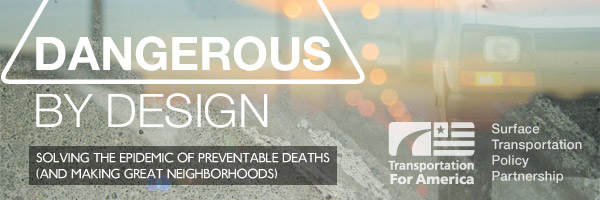 |
| YikesPedestrian Originally uploaded by Transportation for America |
| Look carefully in the turning lane above the center of the photograph. There’s a pedestrian trying to cross this 7-lane urban arterial road. See any crosswalks anywhere on the road? Photo courtesy of Dan Burden. |
Over the last several decades, many of our cities and communities have seen the same shift of daily business from walkable, downtown Main Streets to wide, fast-moving state highways. These “arterial” roads are the new main streets in most communities, drawing shopping centers, drive-throughs, apartment complexes and office parks. Unlike the old walkable main streets, however, the pressure to move as many cars through these areas as quickly as possible has led transportation departments to squeeze in as many lanes as they can, while disregarding sidewalks, crosswalks and crossing signals, on-street parking, and even street trees in order to remove impediments to speeding traffic.
As a result, more than half of fatal vehicle crashes occurred on these wide, high capacity and high-speed thoroughfares. Though dangerous, these arterials are all but unavoidable because they are the trunk lines carrying most local traffic and supporting nearly all the commercial activity essential to daily life.
Before the top 10 most dangerous city rankings, here are just a few facts you might like to know:
Inadequate facilities. Of the 9,168 pedestrian fatalities in 2007-08 for which the location of the collision is known, more than 40 percent were killed where no crosswalk was available.
Spending disparity. Though pedestrian fatalities make up 11.8 percent of all traffic-related fatalities, states have allocated less than 1.5 percent of total authorized transportation funds to projects aimed at improving safety for pedestrians (for funds spent under current transportation bill.) No state spends more than 5 percent of federal transportation funds on safety features or programs for pedestrians or cyclists, despite a 30 percent increase in total federal transportation dollars beginning in 2005.
Complete streets save lives. Providing sidewalks, crosswalks and designing for lower traffic speeds saves lives. Only one in 10 pedestrians deaths occurred within crosswalks, while six in 10 occurred on arterial-type roads where speeds were 40 mph or higher.
The danger is not shared equally. Older adults, disabled and low-income Americans are being killed at disproportionate rates. African-Americans, who walk for 50 percent more trips than whites, and Hispanic residents, who walk 40 percent more, are subjected to the least safe conditions and die disproportionately.
Aging in place, yet unable to leave the house on foot. An AARP poll of adults 50 years and older found that 40 percent reported inadequate sidewalks in their neighborhoods and nearly half of respondents reported that they could not safely cross the main roads close to their home.
| Rank | Metropolitan Area | 2007-08 Pedestrian
Danger Index |
|
| 1 | Orlando-Kissimmee, Fla. | 221.5 | |
| 2 | Tampa-St. Petersburg-Clearwater, Fla. | 205.5 | |
| 3 | Miami-Fort Lauderdale-Pompano Beach, Fla. | 181.2 | |
| 4 | Jacksonville, Fla. | 157.4 | |
| 5 | Memphis, Tenn.-Miss.-Ark. | 137.7 | |
| 6 | Raleigh-Cary, N.C. | 128.6 | |
| 7 | Louisville/Jefferson County, Ky.-Ind. | 114.8 | |
| 8 | Houston-Sugar Land-Baytown, Texas | 112.4 | |
| 8 | Birmingham-Hoover, Ala. | 110.0 | |
| 10 | Atlanta-Sandy Springs-Marietta, Ga. | 108.3 | |
| See the full rankings and download the report | |||
Bay Area bridge shutdown puts transportation network in the spotlight
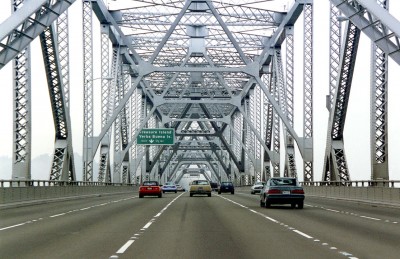 Even in the San Francisco Bay Area, a renowned transit hub with higher than average rates of walking, biking and transit ridership, more than 280,000 vehicles cross the San Francisco-Oakland Bay Bridge every day. It’s a critical artery connecting downtown San Francisco with the thousands of residents who live in Oakland and the surrounding suburbs.
Even in the San Francisco Bay Area, a renowned transit hub with higher than average rates of walking, biking and transit ridership, more than 280,000 vehicles cross the San Francisco-Oakland Bay Bridge every day. It’s a critical artery connecting downtown San Francisco with the thousands of residents who live in Oakland and the surrounding suburbs.
It is thus understandable that panic ensued after a part snapped off in high winds and fell onto the roadway, resulting in a complete shutdown of the Bay Bridge early Tuesday. Thankfully, though at least two vehicles either ran into or hit the fallen part, no injuries resulted. As of this morning, the bridge remains closed without a date certain for re-opening.
The Bay Bridge was last closed down over Labor Day weekend, during which engineers discovered an unexpected crack. This structural flaw nearly delayed the bridge from reopening on-time, but crews received the needed materials in just enough time for the post-weekend morning commute.
It was one of those last minute repair pieces that broke off Tuesday, although engineers could not say whether the Labor Day rush had anything to do with it. Heavy winds are another potential culprit — hardly an uncommon occurrence in the Bay Area, however.
Once the bridge was closed, the immediate focus shifted to the Wednesday morning commute. Prognosticators were predicting mass chaos and never-ending gridlock as far as the eye could see on Wednesday morning.
Officials with the BART subway system arranged for extra train cars and personnel to accommodate the expected surge in passengers, leading to a record day of ridership that crushed the previous high water mark. Ferry agencies across the Bay ramped up service and Amtrak is providing a shuttle. MUNI, AC Transit, and other local agencies also stepped up rates of service and frequency to meet the demand.
| “When the Bay Bridge closed we saw a 49 percent spike in transit use. Thank goodness we had that transit option there.” |
| – Federal Transit Adminstration Administrator Peter Rogoff today at the Rail~Volution Conference |
Despite similar predictions of chaos and gridlock, commuters, transit agencies and officials effectively coped with the collapse of a major overpass near the Bay Bridge in April 2007. Many drivers quickly developed alternate routes or shifted their schedule, BART was effective at expanding capacity and major thoroughfares were crowded, but not gridlocked.
Media accounts accounts for this week indicate Bay Area officials have handled the shutdown relatively smoothly, especially considering how many vehicles use this bridge every day. BART trains were filled to capacity and the Richmond-San Rafael and San Mateo-Hayward bridges — both adjacent to the Bay Bridge — were jammed with cars but still moving, albeit at a sluggish pace.
As far as we can tell, California Department of Transportation officials have been responsive and responsible about safety and structural integrity. It is important they be given the time to get this right.
But even if the time crunch during Labor Day weekend did not contribute to the problem, it should be cause for concern. In too many transportation projects, safety is shelved in favor of speed and grandeur. Part of the Bay Area’s ability to cope is the investment they’ve made in a variety of transportation options and modes. Which begs the question, how would metropolitan areas that lack these alternatives fare if a similar incident occurred?
Diversity of options isn’t just about cutting emissions or reducing fuel consumption. A complete network is one that can continue functioning when a few parts go down. A city dependent completely on cars and interstates (or 1 or 2 transit lines) is a vulnerable city.
Across America, children, seniors, the disabled and people who do not or cannot drive are at risk due to unsafe streets and crumbling sidewalks. We cannot afford to spend untold billions on new projects if we cannot keep old ones from crumbling. Including strong “fix-it first” language in the transportation bill re-authorization would ensure that existing roads and bridges get the upgrades they need to keep commuters and all users safe.
In addition, the Critical Asset Investment Program proposed in Chairman Oberstar’s transportation bill would create a substantial, dedicated funding stream for maintaining roads and bridges, preventing states from diverting those funds to more political popular highway expansion projects. This program would also require transit agencies to show how they are maintaining their systems and keeping them in “a state of good repair.”
The Bay Area will get through this. But the incident is a reminder that transportation policy cannot be a piecemeal, crisis-to-crisis endeavor.
Bay Area business leaders push the Senate for clean transportation
 |
| Carl Guardino 1 Originally uploaded by Transportation for America |
| Carl Guardino, president and CEO of the Silicon Valley Leadership Group, a T4 America partner, addresses a gathering at a recent reception hosted by T4 America that brought together administration officials and supporters. |
An organization representing more than 300 elite Silicon Valley businesses from Apple to Yahoo! sent a letter last week to Senate Environment and Public Works Chairman Barbara Boxer, a California Democrat, urging her to make sure the Senate climate bill adequately invests in clean transportation alternatives to reduce emissions in their region while keeping it mobile and competitive.
The Silicon Valley Leadership Group, made up of mostly tech-focused organizations in Silicon Valley, works to enhance economic competitiveness and maintain a high quality of life for the region. SVLG members employ more than 250,000 people in the Valley and generate more than $1 trillion worth of business each year. (SVLG is a partner of Transportation for America.)
Started in the 1970’s by the founder of Hewlett Packard, they recognize that investments in transit and safe, accessible, walkable neighborhoods are keys to their continued economic success and ability to lure smart and talented workers to the region.
In the letter, president Carl Guardino thanked Chairman Boxer for her leadership on the issue of climate change, and pointed out that California will need to make a large investment in cleaner transportation options if they are going to have any chance of meeting the ambitious reductions proposed in the climate bill:
Transportation represents the fastest growing source of national greenhouse gas emissions (GHG), and the largest single source in California, accounting for 40% of emissions. In Silicon Valley and the Bay Area, that number is higher still – 51% of GHG’s.
House bill, H.R. 2454 (Waxman/Markey), recognizes the importance of reducing transportation emissions by requiring states and metropolitan areas adopt new planning requirements and GHG reduction goals. However, the bill provides virtually no allowances for this purpose. Without adequate funding to address transportation’s increasing contribution to climate change, we will not be able to rise and meet this challenge.
The debate over the Senate’s climate bill is expected to heat up in the next few days as Chairman Boxer’s Senate committee releases the numbers showing where the allocations from the Clean Energy Jobs and American Power Act will be directed.
Transportation for America, our 28,000 supporters and 350+ partners like SVLG have been calling on the Senate to direct 10 percent of the funding to clean transportation alternatives.
The Senate bill will require states and cities to reduce emissions from transportation. Giving them 5-10% of the revenues will give them the tools they need to make investments in clean transportation alternatives, like public transportation and passenger rail, affordable neighborhoods around transit stops and neighborhood projects that increase safety for cyclists and pedestrians.
Click the jump to read through the entire letter from the SVLG.
Local regions serve as laboratories for transportation reform
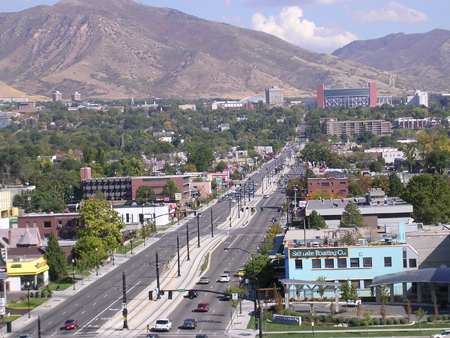 A “comprehensive, but bottom-up approach to transportation” may sound like an oxymoron, but to a panel of regional planning experts on the frontlines of reform, it sounds a lot like common sense.
A “comprehensive, but bottom-up approach to transportation” may sound like an oxymoron, but to a panel of regional planning experts on the frontlines of reform, it sounds a lot like common sense.
Tuesday’s briefing, titled “Planning for a Better Future: Lessons from the States on Regional Sustainability Planning” featured experts from three regional laboratories on transportation reform – Sacramento, CA; Salt Lake City, UT (right); and Minneapolis, MN.
The American Planning Association and LOCUS, an association of pro-reform real estate developers, co-hosted the event at the Capitol Visitors Center on Tuesday afternoon.
Regional blueprints, or plans, outline a long-term transportation vision for a region. Metropolitan Planning Organization, or MPOs, typically have jurisdiction over this process, alongside partners at the county and municipal level. One objective of these plans is to lower greenhouse gas emissions through measures like increased transit use and building new homes near jobs.
“Comprehensive, but bottom-up” is how LOCUS President Christopher Leinberger, the event’s moderator, describes a potential direction for federal policy. In essence, the federal government would provide the funding and set the benchmarks, while regional planning authorities make allocations and are expected to achieve significant reductions in emissions.
Panelists stressed that their primary focus is on increasing choices – in transportation and housing – for all Americans. The recent economic recession was fueled in part by an over-supply of single-family homes on large lots. And while ample demand exists for mixed-use development on smaller lots, a combination of lagging infrastructure and policy restrictions have prevented the private sector from moving to meet that demand.
That is why the engagement and support of the business community is so critical.
Natalie Gochnour is the Chief Operating Officer for the Salt Lake City Chamber of Commerce. Her group’s seat at the table and engagement with a strategic and sustainable vision for the Salt Lake City area led to championing a sales tax increase to pay for 70 miles of light-rail for seven years.
“My message is this: don’t underestimate business community support for new ways of seeing and new ways of doing,” Gochnour said.
Michael McKeever, Executive Director of the Sacramento Area Council of Governments, cited a similar dynamic in his area, where the Sacramento Area Chamber of Commerce helped push the blueprint concept in its early stages and has hailed the region’s long-range plan as a signature accomplishment.
Both Sacramento and Salt Lake City have seen substantial increases in transit usage and decreases in vehicle miles traveled (VMT) since beginning to implement their blueprints.
Commissioner Peter McLaughlin of Hennepin County in Minnesota addressed successes in his region as well.
T4 America Director James Corless emphasized that there was no “silver bullet” in regional sustainability planning, but that providing benchmarks and the required funding would result in substantial leaps.
Communities should be asking, “what do we want to look like in 25 years?” Corless said. “That’s the fundamental question.”
T4 America health fly-in participant meets Senator Barbara Boxer
 |
| Julia Lopez meets Sen. Boxer Originally uploaded by Transportation for America |
Fourteen-year-old Julia Lopez, right, a childhood wellness advocate from Los Angeles, CA, met California Democratic Senator Barbara Boxer in the Capitol yesterday. Lopez is in Washington, D.C. to participate in Transportation for America’s “health fly-in” to speak with Congressional representatives about the link between and health and transportation. Lopez will address her own advocacy against childhood obesity during Congressional meetings and this morning at a briefing in the Capitol Visitors’ Center.
DC helps out area commuters with new Bike Station
 |
| 100_8726 Originally uploaded by BeyondDC and appeared in this post |
Washington D.C. took another great stride towards making bicycling easier and more attractive with the grand opening of Union Station’s BikeStation almost two weeks ago. With the opening of the stunning facility at Union Station, Washington’s most visited destination and travel hub can now connect commuters using trains, buses, cars, subway, or bikes.
(As Ray LaHood said, it’ll help address that “last mile” problem of commuting.)
The BikeStation offers a brand new option for commuting. A train or metro rider can now leave their bike at Union Station without it being stolen, stripped for parts, or damaged by weather. Thus, any commuter who can get to Union Station can now pick up their own, well-maintained bicycle and use it for commuting around Washington.
In New York City, the DOT found out that a safe and secure place to lock up bikes was the number one obstacle preventing more people from biking to work.
A joint project funded by Federal Highway Administration and District of Columbia transportation dollars, the project was built by the D.C. Department of Transportation. Bikestation, which operates 6 other facilities like this one, and Bike and Roll, which rents bikes and leads bike tours for tourists, share responsibility for operating the station.
It is a first for DC, and a totally unique structure designed by Donald Paine of KGP Design Studio to evoke both a bike wheel and helmet. The glass covered arching spine is a striking contrast to the classical Beaux Arts style of Union Station behind it.
The cost per year is $96 as an intro rate, a sum easily covered by the Bicycle Commuter Benefit (available from participating employers). According to Andrea White-Kjoss of BikeStation, they had already sold 40 annual memberships before the station opened. In the days since it opened, the station has already sold 30 annual memberships and Bike and Roll has been renting as many as 20 bicycles a day. Both figures far exceeded initial estimates.
Combined with the existing SmartBike bike sharing system, BikeStation effectively extends the radius in the region from which a citizen can commute within the region without needing to drive. A bike commuter can bike to Union Station, leave their bike, hop on a Metro train or a commuter train, and head out for points beyond without having to drive.
It’s all about increasing transportation options, and BikeStation is a great one for the city.
It’s time to make the link between health and transportation
Most of the news coverage about what is happening in Washington compartmentalizes health and transportation, missing key connections between the two.
This week, Americans from around the country will speak to their representatives, seeking to emphasize those links. The “health fly-in” will commence Thursday and is sponsored by Transportation for America, the American Public Health Association, the Complete Streets campaign and PolicyLink, a research institute specializing in social equity.
The U.S. transportation system – our roads, bridges and highways, as well as bicycle and pedestrian paths – propels our social and economic lives. Unfortunately, the system we have takes a significant toll on our health and safety.
By building neighborhoods, towns and cities that require a car trip for nearly every move we make, we have literally engineered physical activity out of our daily lives. In many sprawling communities, driving is the only option for getting to school, work and recreation, and new road projects tend to favor speeding cars over the people who cross the street.
Poor air quality resulting from pollution contributes between $40 billion and $60 billion to U.S. health care costs annually. Each hour spent in the car increases the risk of obesity. And further, the lack of emphasis on transit, walking and biking lowers mobility for disadvantaged Americans and makes our streets less safe for people both behind the wheel and on foot.
Transportation policy can no longer be viewed in isolation. That is why groups like the American Public Health Association are educating people about the links between the built environment and our personal well-being and organizations from different policy arenas that never saw the need to work with each other before are joining hands.
This week has been all about making the health and transportation link more concrete, and there is more to come.
Republican Senator says more transit = better health
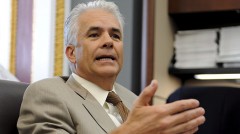 Last week, an offhand comment by Republican Senator John Ensign about the link between health and transportation policy didn’t make the headlines, but it did make an interesting connection.
Last week, an offhand comment by Republican Senator John Ensign about the link between health and transportation policy didn’t make the headlines, but it did make an interesting connection.
Ensign was wrong in asserting that the United States has the highest life expectancy among developed countries when gun and automobile accidents are ignored. But he was on target when he mentioned America’s auto-dependent ways and how that negatively impacts our health.
Compared to Europe, “we’re just a much more mobile society,” he said. “We drive our cars a lot more, they do public transportation. So you have to compare health care system with health care system.”
While misunderstanding mobility as just traveling a high number of miles, Ensign correctly implies that driving more and walking less contributes to poor health and makes us more prone to death (in a car) than our European neighbors, which the data suggests to be true. The most obese cities in the United States — Miami, Oklahoma City and Ensign’s own constituents in Las Vegas — are known for their auto-oriented sprawl.
A recent study in the Journal of Physical Activity and Health confirms a correlation between the more active walking habits of Europeans and lower obesity rates, backing up American research from earlier this decade by Smart Growth America and others showing that residents of sprawling places are more likely to be obese.
If we want to boost mobility while bringing health costs down, we need our transportation policy to create more travel options for everyone and make it safer and easier to walk and bike.
Mobility isn’t an end of itself, nor is it just about going long distances on a regular basis. Mobility is about access to destinations and opportunity. We’re spending hours in the car not because ordinary Americans think that having high “mobility” is important — we’re doing it out of necessity just to get around our increasingly spread out cities.
No one would argue that our transportation priorities are the driving force — no pun intended — behind lower health outcomes. But there is enough evidence to suggest they should be a serious part of the discussion.
California Supreme Court hands victory to local transit riders and providers
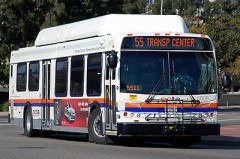 A recent California Supreme Court decision could restore billions in funding for public transportation in the nation’s most populous state.
A recent California Supreme Court decision could restore billions in funding for public transportation in the nation’s most populous state.
The Court’s ruling late last week upheld a lower court decision declaring the state’s $3.6 billion raid of public transit funds illegal and ordered that the money be returned to local transit providers.
Two months ago, Transportation for America released “Stranded at the Station: The Impact of the Financial Crisis in Public Transportation,” illustrating the painful cuts transit systems have sustained at the state and local level. The cuts plateaued as unemployment reached 10 percent and Americans were demanding more transportation options, not less.
It is no secret that California has fallen hard as a result of the recession, but the severity of the cuts to public transportation in California was vastly disproportionate to the rest of the country. The reason for this was no mystery: the State was raiding dedicated transit funds every year in order to alleviate other budgetary shortfalls since 2007.
More than two dozen transit providers throughout the state enacted some combination of fee hikes and service reductions, according to our map of transit cutbacks. BART in the San Francisco Bay Area increased its base fare by 17 percent, and many transit systems in Southern California raised fares as much as 20 percent. The County Connection in suburban Contra Costa reduced its bus lines by 23 percent, and rural areas were hit hard as well. The California Transit Association, or CTA, an affiliation of local transit providers, logged 38 agencies facing cuts of some kind in their own version of our transit cuts map.
Last week’s state Supreme Court’s decision helps explain how things got this bad.
Since 2007, Gov. Arnold Schwarzenegger has successfully diverted $3.6 billion from the state’s transit fund to deficit reduction, prompting a lawsuit from the CTA to get the money back. The CTA argued that the raided funds came from gas tax revenues specifically designated for public transit. By refusing to review a lower-court decision in favor of the association, the high court effectively ruled Schwarzenegger’s raid illegal, ending the seizure of desperately-needed transit funds.
This is a huge victory and vindication for local transit providers. Randy Rentschler, director of the Bay Area Metropolitan Transportation Commission, told the San Francisco Chronicle, “everyone knows that the state’s in a budget crisis, but that crisis also exists in local governments in part because the state has taken transit money away from local entities.”
The case has broader implications for public transportation as well.
In tough budget years, Governor Schwarzenegger and the legislature are constantly looking for places to trim and local governments are an easy target. But money saved is not money earned, as local cuts tend to bite the state later through increased demand for social services and counties being unable to meet the basic needs of their citizens. The decision will hopefully lead to more caution.
Most importantly, California can no longer rob Peter to pay Paul.
But at this point, it remains unclear how much of the original $3.6 billion will be returned to the transit fund, and ultimately, to local providers to preserve vital service for riders. That money is desperately needed, not only because of the millions of Californians who rely on public transportation for their day-to-day mobility, but also because many communities are on the cusp of becoming success stories. Transportation for America’s “Stranded” report profiles how efforts in Sacramento, Orange and Contra Counties have already improved quality of life and relieved congestion, highlighting the need to keep up the support.
FAQ: What are rescissions? Will my state lose transportation money?
Friday, we explained the details surrounding the expiration of the transportation bill on Wednesday night and the one-month extension that was passed. Read that here. Due in part to the failure of a bipartisan plan to shift some revenue to satisfy House budget rules, the states are also losing a total of $8.7 billion in transportation spending, known by the unmistakably Washington-transportation-insider term of a “rescission.”
Here’s our attempt to simplify that issue just a little bit for those who are interested in the policy details. Non-wonks, feel free to skip over this one. Just a fair warning! Click through the jump to read in its entirety. (more…)
FAQ: Transportation bill expires, emergency extension passed
 |
| The Senate Garage Fountain (Olmstead Fountain) and the US Capitol Originally uploaded by kimberlyfaye |
UPDATED: We posted a similar question-and-answer document covering the specific issue of rescissions. Read that here.
As you may have read on Streetsblog Capitol Hill, where Elana Schor has been closely tracking the inexorable march toward expiration of the old transportation bill (SAFETEA-LU), the Senate passed an emergency one-month extension of the current law last night, just hours before the deadline.
There have been a lot of questions flying around today, so we’re going to try to post some simplified answers to clear up any confusion. Federal transportation policy is not the simplest code to decipher, but we’ll try our best to start with the basics.
The short explanation?
The Senate failed to pass an extension of their own to match the House’s recent 3-month extension before the transportation bill expired last night.
To prevent transportation spending from stopping entirely, Congress added a one-month extension of current transportation law to a last-minute bill (a Continuing Resolution) that keeps the federal government from shutting down in case they don’t pass the required individual spending bills for the next year. The one-month Continuing Resolution did not address the scheduled loss of $8.7 billion in transportation funds that will be taken from states, starting today.
Click through the jump below if you want much more detailed information. (more…)
Using some creativity to get around in Atlanta today
You’ve likely seen the news coverage out of Atlanta yesterday and today, where torrential rainfalls over the last week resulted in massive flooding in Atlanta and surrounding counties. A couple of enterprising folks made the best of the disastrous situation, finding another mode of transportation for getting around. This is the Krog Tunnel that runs under the CSX railroad tracks just east of downtown Atlanta. And it normally looks like this.
Wow.
 |
| 1200IMG_8209 Originally uploaded by Caroline E Smith |
| Krog Tunnel in Atlanta, GA |
Tell Congress to make a historic investment in high speed rail
Congress is heading towards a decisive, historic moment on investing in high speed rail for America. But the outcome is far from certain.
In the next few weeks, Congress will decide whether or not to give the Department of Transportation $1.2 billion or $4 billion on high speed rail for the next year. $8 billion was allocated for planning and implementing clean, efficient, high speed train travel in the economic stimulus earlier this year, and with another $4 billion, we’d be making a historic $12 billion investment in high speed rail to help us move into the 21st century, unclog our congested airports and airspace, and provide a new clean, efficient alternative for speedy travel between major metro areas.
Sometime in the next week or two, Congress will decide whether or not to give DOT the amount in the House version of the bill ($4 billion), or the Senate version ($1.2 billion).
Tell Congress to keep $4 billion in the bill at www.fourbillion.com
Transportation for America is partnering with U.S. PIRG, Virginians for High Speed Rail, and the Midwest High Speed Rail Association to send a message to Congress that now is the time to make a historic investment in high speed rail.




Want the wonky details? As you may remember, the Senate passed the bill that funds the Department of Transportation and the Department of Housing and Urban Development last week. The bill that passed last week is what’s known as a (yearly) appropriations bill, where the budget for the department and the programs are finalized and officially given their money by Congress. The House passed their version of the DOT/HUD funding bill several weeks ago, so the differences between the two bills will be ironed out in a conference committee very soon. The House and the Senate will select conferees to reconcile the two versions of the bill, before sending a final bill back to the House and Senate for a last vote and then to President Obama’s desk.
Let’s tell them to send the president a bill with $4 billion for high speed rail.

Post this action on Twitter, or with other tools via the button below.
PBS Blueprint America looks at freight, rail, and trucks
PBS continued their excellent Blueprint America series with an episode on NOW last Friday night examining the issue of freight movement in America. Watch it below or over at the terrific Blueprint America site.
What’s the impact of the Highway Trust Fund patch or an extension of the current bill?
UPDATED 7/30: The Senate passed the $7 billion patch late this afternoon by a 79-17 vote. All 4 amendments failed, so the identical bill has been approved by both chambers and now heads to President Obama’s desk for signature.
With the House passing a $7 billion patch for the Highway Trust Fund yesterday afternoon to keep it from running out of money before September, we thought it might be useful to post a brief Q&A about the trust fund patch and how the full six-year transportation authorization bill could be affected. The $7 billion patch now moves to the Senate for a vote, probably this afternoon, before reaching President Obama’s desk. The Highway Trust Fund (HTF) provides funds for the federal portion of transportation projects.
If the patch is approved by the Senate, Congress will then be is now facing a much bigger decision before the current transportation bill expires on September 30th: pass a new six-year transportation bill, or pass a short- or long-term extension of SAFETEA-LU, the existing transportation bill.
What is the short-term patch and who supports it?
The short-term patch would repair the trust fund insolvency through a $7 billion cash infusion into the HTF. The funds would be transferred from the General Fund before Congress goes on recess in August and would ensure that states can continue to obligate transportation funds through September 30th, 2009. The patch would address the funding shortfall due to declining gas tax revenues that are no longer sufficient to cover the federal portion of transportation projects.
House Transportation and Infrastructure Committee Chairman Jim Oberstar supported this option and testified before the House Ways and Means Subcommittee on July 23rd asking for the $3 billion patch. (That patch has since been increased to $7 billion to match the Senate’s preferred amount.)
How does this relate to the upcoming expiration of SAFETEA-LU on September 30th?
With this cash infusion Congress could continue to focus on pushing the authorization of a new 6-year surface transportation bill this September. The original $3 billion figure was based on recent estimates made by DOT but both the White House and DOT officials have expressed concern that $5-7 billion is a more accurate figure needed to keep the HTF solvent through September. (The House passed a $7 billion patch.)
What is the extension and who supports it?
An extension would continue SAFETEA-LU policies and funding guarantees for a specified amount of time to allow Congress and the Administration to continue working on a full 6-year comprehensive bill. A proposed 18-month extension would extend SAFETEA-LU to March 2011. Numerous Senators have stated their preference for an 18-month extension, which is also currently supported by the White House. On July 23rd the Senate Banking Committee became the third Senate committee to approve an 18-month extension bill. Congress is also considering the possibility of a short-term extension of 3, 6, or 12 months in lieu of a longer-term extension.
How would the extension be funded and how does it address the near-term shortfall in HTF funds?
An extension of SAFETEA-LU for any length of time would be paid through gas taxes and a possible General Fund infusion. (More funding from some source would certainly be required, as gas taxes do not cover the current funding levels.)
The Senate Financing Committee Chairman Max Baucus released a funding proposal (S. 1474) on July 21st that would maintain the HTF’s solvency throughout an 18-month extension. This provision will transfer $26.8 billion from the General Fund to transportation ($22 billion to HTF, $4.8 billion to the mass transit account). The fund transfer will begin in time to provide near-term funding (through August) before HTF reaches insolvency.
Any questions? Ask away in the comments and we’ll try to answer.
Cellphones and texting pose great risks behind the wheel
Last week, the New York Times covered the news that the National Highway Transportation Safety Administration decided in 2003 not to release preliminary data showing that talking on cellphones while driving — whether using a hands-free device or not — posed a safety risk nearly equivalent to drunk driving. Researchers at the NHTSA were pushing for a more extensive research program to follow their preliminary research, but due to what the Times cited as “political considerations,” not only was the extra study and research not ordered, but the existing findings were essentially buried.
The memos, research and draft letter to Department of Transportation Secretary Norman Mineta were released to The Center for Auto Safety and Public Citizen via a Freedom of Information request, who sent them to the Times.
The NHTSA officials were encouraged to stick to their mission of information-gathering and to avoid lobbying states to pass laws restricting cellphones in any way. But what good is information gathering when the results don’t leave the agency, much less find their way into the hands of lawmakers or state legislators?
The news in the Times‘ Driven to Distraction series only got worse yesterday.
The Virginia Tech Transportation Institute is releasing a peer-reviewed report showing that truckers who text message while driving were 23 times more likely to crash. The study outfitted tractor-trailer drivers with cameras to study their behavior and found that “in the moments before a crash or near crash, drivers typically spent nearly five seconds looking at their devices — enough time at typical highway speeds to cover more than the length of a football field.”
Tom Dingus, director of the Virginia Tech institute, one of the world’s largest vehicle safety research organizations, said the study’s message was clear.
“You should never do this,” he said of texting while driving. “It should be illegal.”
Most shocking perhaps was the closing story. If you happen to live near Windham, Maine, you might want to keep an eye out, though this sort of behavior is more common than one might think. According to a survey of 2,501 drivers in the story, “21 percent of drivers said they had recently texted or e-mailed while driving,”
“It’s convenient,” said Robert Smith, 22, a recent college graduate in Windham, Me., who says he regularly texts and drives even though he recognizes that it is a serious risk. He would rather text, he said, than take time on a phone call.
“I put the phone on top of the steering wheel and text with both thumbs,” he said, adding that he often has exchanges of 10 messages or more. Sometimes, “I’ll look up and realize there’s a car sitting there and swerve around it.”
Mr. Smith, who was not part of the AAA survey, said he was surprised by the findings in the new research about texting.
“I’m pretty sure that someday it’s going to come back to bite me,” he said of his behavior.
Wrapping up the Minnesota release of the Blueprint
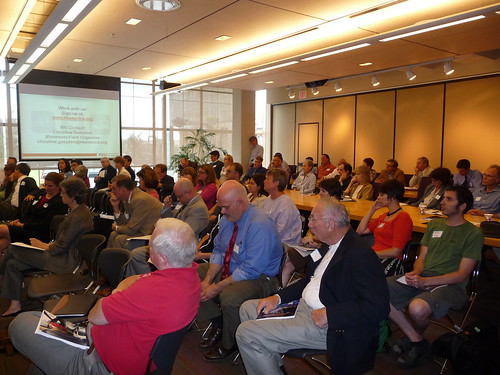 |
| P1000963 Originally uploaded by Transportation for America |
On Monday, June 29th the Minnesota Coalition of Transportation for America welcomed community, city, and state leaders to learn more about the T4 America vision for the next federal transportation bill — and how Minnesotans would benefit from a reformed federal transportation program.
The event, hosted by the McKnight Foundation in Minneapolis, was attended by city officials, state legislators, congressional offices, business leaders, labor groups and advocacy organizations from across the state. The packed room heard from Anne Canby and Mariia Zimmerman, the Washington, D.C. representatives of the T4 America campaign, as they walked through the campaign’s Route to Reform, a detailed blueprint for the transportation bill.
The meeting came on the heels of Chairman Oberstar releasing a draft 775-page transportation bill he hopes to pass before the current federal bill expires in September. In describing how Oberstar’s bill fits in with the T4 America vision, Anne Canby said that the draft is “on the right track,” and that “Oberstar is full of fire and ready to go. He has filled a vacuum with his leadership.”
Minneapolis Mayor R.T. Rybak, Hennepin County Commissioner Peter McLaughlin and State Representative Frank Hornstein highlighted how Minnesota communities would benefit from sweeping reforms in the transportation bill. In describing the need for new federal transportation policy as proposed by the T4 America campaign, Mayor Rybak indicated that “we shouldn’t strive for less” but that Minneapolis and the State have to be ready for it. Michael Lander, a developer with many projects around the Twin Cities, also spoke about the need to include land use discussions when planning any transportation project because “transportation has always driven development.” He noted that the T4 America vision is “planning to meet the coming demand” for housing in convenient, walkable locations with access to public transportation.
| “The market is changing dramatically, and walkable urbanism is what the market is looking for. …Central to the T4 America reform is planning to meet the coming demand.” |
| — Michael Lander |
In attendance were representatives from Chairman Oberstar’s office, Congressman Ellison and Congresswoman Betty McCollum’s offices. State legislators, including Rep. Hausman and Rep. Kahn, county commissioners and city staffers from St. Paul and Minneapolis were among the crowd eager to hear about the work being done to create federal transportation policy that would benefit their communities.
It was not a strictly metropolitan affair as the Mayor of Independence and a representative from State Sen. Clark’s office from St. Cloud came to hear about how smaller and more rural communities could also get their transportation needs addressed in the federal bill.
One concern all of the elected officials shared was making sure Minnesota’s roads, highways and bridges were in a state of good repair. Rep. Hornstein noted that we cannot invest in a “fax machine on the dawn of the internet revolution” indicating that we need to reach what he calls “infrastructure 2.0.”
“Infrastructure 2.0 is what is in this Transportation for America plan.”
Seattle opens new light rail system, residents get a new “Link”
Seattle opened a new light rail system this weekend, and it was a smashing success by all accounts. Ridership from the inaugural weekend was over 90,000, and the system is settling into normal revenue service today. Read all about it from fellow Streetsblog Network member Seattle Transit Blog, and check out a huge batch of photos from opening weekend in their Flickr group pool.
 |
| Big crowd Originally uploaded by Mike Bjork |
 |
| DSC_5700 Originally uploaded by Seattle Transit Blog |
56 million people in rural America looking for better transportation solutions
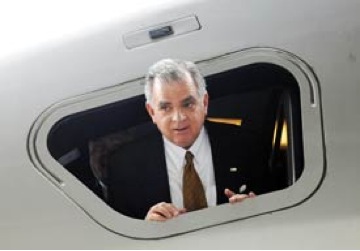 A top priority in the transportation debate is addressing the mobility needs of the 56 million residents of rural areas and small towns in America – about 20 percent of the population of the United States. Rural areas and small towns often fall through the cracks of federal transportation policy, which focuses on statewide priorities for building new highways and often overlooks local needs and preferences.
A top priority in the transportation debate is addressing the mobility needs of the 56 million residents of rural areas and small towns in America – about 20 percent of the population of the United States. Rural areas and small towns often fall through the cracks of federal transportation policy, which focuses on statewide priorities for building new highways and often overlooks local needs and preferences.
Access to jobs, schools, shopping, and critical community services is just as vital for Americans living in small cities, towns and rural communities. Transportation for America has been working closely with our coalition partners on this important issue for some time. Now, it looks like Secretary of Transportation Ray LaHood is also getting on board.
Listening to folks at the La Crosse Interstate Fair in Wisconsin this week, he heard many of the same things that we already know:
- It’s getting harder financially to depend on a truck or car for all of a family’s transportation needs.
- Rural residents need public transportation just like city-dwellers do.
- Access to commercial air service is increasingly difficult for rural areas.
- Shippers of grain and other products need better freight options to get rurally produced goods to markets.
Clearly, the transportation system in rural areas and small towns faces challenges and demands that are unique from those in our metropolitan areas. Small cities and towns have higher concentrations of older Americans and families in poverty who would absolutely benefit from more affordable transportation options, beyond just driving. In addition, children in rural areas are 25 percent more likely to be overweight or obese than those in urban areas and face unique barriers to being active and maintaining a healthy weight. Non-metro areas have a larger share of people over age 65 (15 percent) than the country as a whole (12 percent) particularly across the middle of the country. (According to 2004 numbers.)
These challenges are amplified by global changes in the economic marketplace, insufficient funding to maintain substandard or unpaved roads, improve public transportation services, and upgrade or replace substandard and deteriorating bridges.
Our nation’s transportation infrastructure should provide access for all Americans, regardless of their geographic location, age, income, or disability status. While there are no easy answers here, Secretary LaHood’s comments are a good starting point for reframing the debate towards policy options that benefit all Americans, regardless of geography.
Improving access to healthcare by improving transportation options
 |
| Photo by Dan Burden |
Yesterday we noted transportation’s impact on health care costs, and how expanding access to public transportation and investing more money in complete streets safe for walking and biking can improve overall health and lower healthcare costs.
At the same time, we should remember that having transportation options and the ability to easily get where you need to go have a huge impact on whether or not you receive care. Folks who can’t get to the doctor or who must wait on rides from family and friends are more likely to stay sick.
A study of over 1,059 households in 12 western North Carolina counties tests the relationship between transportation options and healthcare utilization while adjusting for the effects of personal characteristics, health characteristics, and distance. The report found that people with reliable access to healthcare visited their doctor 2.29 times more frequently for serious illness and 1.92 times more frequently for regular checkups than those who did not.
The ability to reliably and affordably make it to doctor’s visits or healthcare appointments is also a matter of transportation equity. Minorities, households in rural areas, the disabled, and low-income Americans face even greater hurdles because many cannot drive and public transportation is often unavailable, inaccessible or unreliable. (Not to mention public transportation, paratransit or dial-a-ride programs being cut left and right)
We already know Americans are tired of being stuck in traffic and are clamoring for more options for getting around. But they are also demanding prevention as a top health care reform priority, and overwhelmingly support increasing funding for prevention programs to reduce disease and keep people healthy.
Meeting the health care needs of all Americans will require funding infrastructure projects that can create more opportunities for physical activity. The healthcare bill Congress is currently working on is just another opportuniy to demand that transportation options and access issues are more broadly included in the debate. It is not just the cost of care, but the ability to access that care that’s proven to reduce hospitalization rates for chronic conditions.




